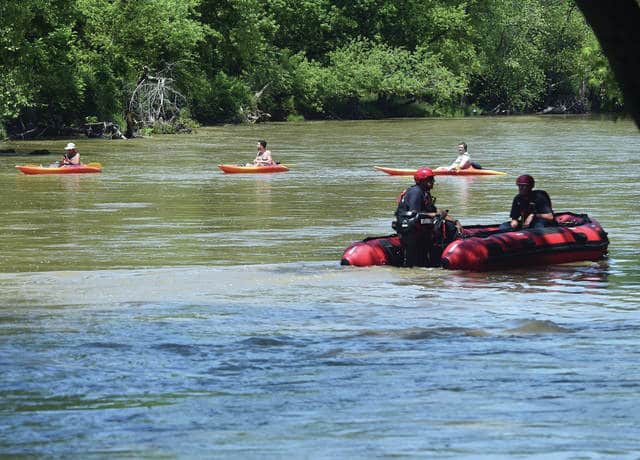
First Responders from Huber Heights move upstream in a rubber boat to assist in a recent water rescue as other kayakers paddle downstream during a moderately high water event following several days of rain.
MIAMI COUNTY — Summer is here.Kayaks, canoes, rubber rafts, inner tubes, will all be floating down the local waterways, carrying paddlers who are out to beat the heat and have fun.
Summer is also the season where local fire departments and rescue squads can count on getting calls to undertake water rescues. First Responders will face calls from medical emergencies that happen on the water and also be called to rescue paddlers who get in “over their head” … literally.
As with any outing, a little pre-planning can make your day more enjoyable. Being prepared before going on the water can make the difference between a day of fun and a day of tragedy.
Let’s begin at the beginning. If you plan to transport your kayak or canoe on your own vehicle, make absolutely certain that it is secured. An unsecured load on any vehicle can quickly become a flying “weapon”, causing injury, or even death, to other motorists.
Tipp City resident and avid kayaker Diane Brown offered some safety tips for paddlers during a recent interview.
One of the most important rules on watercraft is to always wear a life vest. That is state law.
High on Brown’s list was insuring that your watercraft arrives at your chosen recreation site, safe and intact.
“Learn to read the river,” said Brown, “Know the water conditions before you enter the water.” Brown suggested a visit to https://waterdata.usgs.gov/oh/nwis/rt before embarking on your trip. The site gives water conditions, including speed of current and flood conditions.
Some area waterways now have highway road signs attached to bridges as paddlers move downstream. Watching these signs as you cross under the highways allows paddlers to pinpoint their location to First Responders and dispatchers in the event of an emergency.
Brown said that there are a number of “meet sites”, such as www.meetup.com, for people to form impromptu paddling trips on a variety of waterways. While many love to float down the river in solitude, having paddling companions adds an element of safety. The site is also very useful for those who love make new friends of those with similar interests.
One of the most common issues faced by First Responders is whenever heavy rains bring high water to the area. Amateur watercraft enthusiasts see the swift-moving water and see it as an opportunity to experience real “white water” paddling, just like the videos they watch on web sites. This is, without a doubt, the most dangerous time to be on the water as heavy rains and rushing water cause brush, even large trees, to wash downstream before becoming lodged on small islands and bridge piers. In the fast-moving muddy waters, these obstacles cannot even be seen until it is too late.
Many paddlers, especially younger ones, believe themselves to be able to deal with such dangers … or … it “won’t happen to me.”
Brown points out that knowing your skill level and not exceeding your limitations as a paddler are key to survival on the water.


